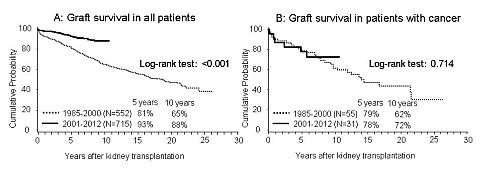Incidence of Malignancy after Kidney Transplantation in the New Era of Immunosuppression
Department of Urology, Tokyo Women's Medical University, Tokyo, Japan
Meeting: 2013 American Transplant Congress
Abstract number: D1714
Introduction: Transplant recipients have elevated cancer risk, due in part to immunosuppression and infection with oncogenic viruses. Although recent immunosuppressive therapy using basiliximab and rituximab have improved the graft survival rate, the incidence of malignancy after kidney transplantation using recent immunotherapy is unclear. In this study, we examine the incidence of malignancy at our institute among deceased and living donor kidney transplants occurring between 2001 and 2012.
Method: In this retrospective cohort study, prospectively collected clinical data from 715 consecutive kidney transplants occurring between January 2001 and March 2012 were examined. We also retrospectively reviewed 552 kidney transplants between 1985 and 2000 as control group. Chi-square tests were used to compare the incidence of malignancy between two groups.
Results: Of 715 patients, 31 (4.3%) cases of malignancy were identified with median follow-up of 81 months. In control group, Of 552 patients, 55 (10.0%) cases of malignancy were identified with median follow-up of 178 months. Renal cell carcinoma represented 16.1% of the cases. Other common malignancies included uterus (12.9%), breast (12.9%), PTLD (9.7%) and prostate (9.7%). Six hundred ninety-one (96.3%) patients received tacrolimus (TAC), 678 (94.8%) received mycophenolate mofetil (MMF), 502 (70.2%) received basiliximab (BAS), 316 (44.2%) received rituximab (RIT) and all patients received no induction of azathioprine between 2001 and 2012. The graft survival rate between 2001 and 2010 is significantly higher than that between 1985 and 2000 in all kidney transplant recipients. On the other hand, there is no significant difference between two groups regarding graft survival in patients with cancer (Figure 1A and 1B).

Conclusions: Although limitation of different follow-up periods compared to that in control group is exist in this study, the new era of immunosuppressive regimen using TAC, MMF, BAS and RIT were not associated with negative impact to the incidence of malignancy.
To cite this abstract in AMA style:
Omoto K, Shimizu T, Inui M, Nozaki T, Toki D, Ishida H, Tanabe K. Incidence of Malignancy after Kidney Transplantation in the New Era of Immunosuppression [abstract]. Am J Transplant. 2013; 13 (suppl 5). https://atcmeetingabstracts.com/abstract/incidence-of-malignancy-after-kidney-transplantation-in-the-new-era-of-immunosuppression/. Accessed December 13, 2025.« Back to 2013 American Transplant Congress
